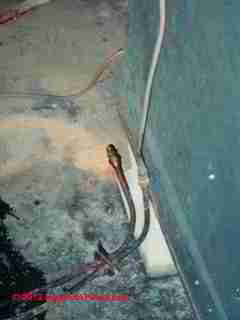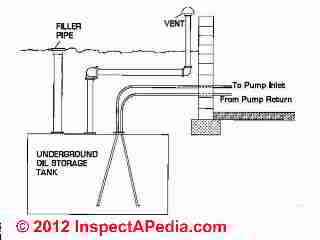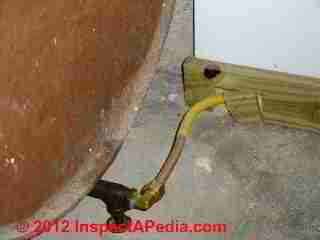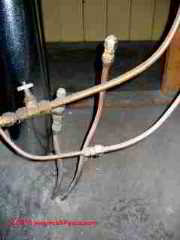 Heating Oil Line De-Clogging Guide
Heating Oil Line De-Clogging Guide
- POST a QUESTION or COMMENT about how to de-clog a furnace oil line, or a clogged boiler or water heater oil pipe line
Oil line clogging: cause & cure.
This article describes the causes and cures of blocked or clogged fuel oil piping or lines that are used to deliver heating oil to oil fired furnaces, boilers, or water heaters.
We give emergency steps to keep heat working when the oil line is blocked and we describe alternatives to try before going on to replace an old clogged fuel oil pipe line.
We discuss using heating oil piping vacuum gauges, pressure gauges, and both hand pumps and CO2 blowout guns to diagnose, test, & repair clogged fuel oil piping lines.
InspectAPedia tolerates no conflicts of interest. We have no relationship with advertisers, products, or services discussed at this website.
How to clear or un-block a clogged heating oil line
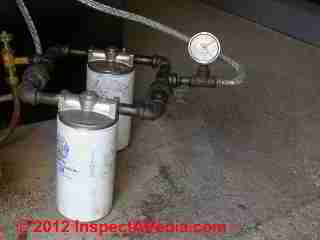 Symptoms of furnace, boiler, or water heater oil line clogging
Symptoms of furnace, boiler, or water heater oil line clogging
Often there are symptoms of a clog or blockage problem developing in a heating appliance oil line before the line is totally blocked. Here we discuss cures for a clogged or blocked fuel oil line.
How do you de-clog or un-block a clogged heating oil fuel line? Guide to Unclogging a blocked furnace, boiler, or water heater fuel oil pipe line.
Where to buy & how to use hand pumps, fittings, vacuum gauges, pressure gauges, & CO2 blowout guns to diagnose, test, & repair clogged fuel oil piping lines.
A clogged or blocked heating oil line can cause buzzing or vibration noise, oil line leaks, and ultimately intermittent failures of the oil burner to ignite or to keep running, the system going "off on reset", a poor oil burner flame, and ultimately simply loss of heat when the burner will no longer start.
If your heating appliance includes an oil vacuum gauge on the oil piping (sometimes but not usually installed) you may see abnormally high oil line vacuum readings - the fuel unit is sucking away on the oil line but is having trouble pulling oil through the system.
Keep in mind that a high vacuum can also develop if the gauge is downstream from a blocked or dirty oil filter. Vacuums greater than minus-10 psi may indicate a blockage.
Westwood Products [2] and other suppliers distribute pump tester gauge sets (Reillo pump testers and vac-probe oil line access port testers) that can als be used to detect problems with the heating appliance fuel piping system such as blockages and leaks.
What causes a heating appliance fuel oil line to become blocked?
Fuel oil piping for oil fired furnaces,oil fired heating boilers, and oil fired water heaters can become blocked due to
- A bend or kink in the oil line that reduces flow and collects debris upstream of the blockage
- Sludge passing from the oil tank out into the fuel line, particularly in systems whose oil piping is supplied from a connection at the bottom of the oil tank
- Mud or other crud that enters the oil tank or heating equipment when a building is flooded during a storm, hurricane, etc. -
see OIL LINE UNBLOCKING after HURRICANE or FLOOD DAMAGE - Rust from an oil tank entering the oil piping
- Heating equipment being left off for long periods of time
- Heating oil that waxes or gels due to exposure to cold weather where the oil storage tank is located outdoors or is otherwise in an unheated area -
see HEATING OIL CLOUD WAX GEL POINT - Water or ice entering or blocking the heating fuel oil line in freezing climates where the oil storage tank is located outdoors or is otherwise in an unheated area -
see OIL TANK WATER CONTAMINATION
and also OIL TANK WATER REMOVAL
How to Confirm that a Heating Oil Line is Blocked
Start by checking vacuum gauge readings on the oil line as we described above.
A hand pump or CO2 cartridge oil line blowout gun can be used to pressurize the oil line between its (for this purpose disconnected) end at the oil filter and its inlet at the oil tank.
- If no pressure develops, then the oil line is clear.
- If pressure is developed but falls, you may be successfully pushing the blockage back into the oil tank. If pressure is developed and does not fall, the oil line is blocked and you are not clearing it.
How to De-Clog or Un-Block a Clogged Heating Oil Fuel Liine
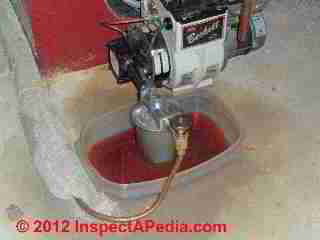 Remedies for a clogged heating oil line depend in part on an assessment of just why the line has become blocked. IN the list above we give links to some oil line blockage problem causes and solutions.
Remedies for a clogged heating oil line depend in part on an assessment of just why the line has become blocked. IN the list above we give links to some oil line blockage problem causes and solutions.
First check the oil filter for clogging or blockage
Before assuming that the heating oil line has become clogged with sludge, rust, waxed heating oil or ice, check the oil filter condition.
Turn off the oil supply ahead of the oil filter (if it's at the burner).
See OIL SUPPLY LINE SAFETY VALVE TURN DIRECTION to OPEN or SHUT
Open the oil filter canister and take a look for thick goop inside the canister and on the outside of the oil filter cartridge itself.
Remove the oil filter: Pull out (and dispose of) the oil filter itself. Now look in the bottom of the oil filter canister base for thick deposits of goop.
Clean that mess out. Also look for rust in the canister bottom - an indicator of excessive water in the oil storage tank.
Install a new oil filter,
Reassemble the unit,
Bleed out the air from the unit, and
Check for functional oil flow.
More details are
at OIL FILTERS on HEATING EQUIPMENT.
Using a Blowout Canister to Clear an Oil Line
Try using a pressure and vacuum hand pump or a CO2 blowout gun with CO2 cartridge to blast open a clogged heating oil line
More generally, if the heating service tech thinks that the oil line is blocked by sludge or debris, before replacing the line s/he will often attempt to blast the debris and crud backwards from the connection at the oil burner all the way back into the oil tank. There are three approaches we've seen HVAC techs use:
- a CO2 blowout gun is attached to the oil line at the fuel unit and used to send a blast of carbon dioxide backwards through the oil supply line
- a hand pump is attached at the oil line and is used to try to clear the oil line
- a small canister of compressed air along with appropriate fittings is used as the CO2 blowout gun method - I [DF] have used this more-gentle piping or tubing de-clogging method successfully when the amount of clogging is minimal and the material can be blown out of an opened end of the tubing or pipe.
Why might that approach work? Because it's common for some sludge to accumulate in the bottom of older oil tanks; the tank is installed (or should be) pitched slightly away from its bottom oil outlet port so that oil tank sludge or water that collects there (as long as it's not too much or too deep) will be kept away from the oil line.
Heating oil line cleanout or blasting is attempted using compressed air or more commonly a small portable canister whose end fittings accept a connection to the oil line flare fitting. The canister's other end accepts a CO2 cartridge. When the service tech screws the oil line blaster canister cartridge fully shut, a pin opens the CO2 cartridge, sending a blast of carbon dioxide backwards through the oil line.
If this quick and easy approach clears the oil line, you're back in business. (One may still need to bleed air from the oil piping lines after the fittings are reconnected).
CO2 blowout guns and replacement CO2 cartridges are sold by HVAC suppliers, including Westwood Products.[2 ]
Watch out: excessive pressures applied to the heating oil line can damage the piping, blow out the line, fittings, or other components, and can cause an oil spill in the building. Some oil line blowout gun models include a built-in safety valve to limit the outlet pressure to 150 psi to avoid this hazard.
Watch out: using a blowout gun or any high pressure method to try to clear a buried oil line is dangerous.
The risk is that you create an underground oil leak - very costly to clean-up and repair. I'd use a hand pump or the (more popular) CO2 blowout gun that limits its output pressure to within the design range of the oil piping system, and I prefer to use only very low pressures to feel your way into clogs in buried oil lines.
Emergency steps to keep heat running with a clogged oil line
For buried oil tanks or other oil tank installations that use a dual oil line piping arrangement, one oil line is the supply (the one that has become clogged) and the second line is a return pipe that sends excess oil back to the oil storage tank.
Typically these installations insert the two oil lines through the top of the oil storage tank, and down into the tank to perhaps 6" from the tank bottom, and spread apart several feet (by bending the lines) so that the agitation of oil tank bottom sludge caused by the returning oil does not send sludge up through the oil pickup pipe.
If this is the arrangement at your oil tank and provided that the problem oil line is not totally blocked, we might keep heat running by temporarily switching the roles of the oil feed and oil return pipe.
That's because oil flowing backwards from the oil burner fuel unit (oil pump) to the oil tank has been filtered (before entering the oil pump) and will be less likely to have already clogged the return line.
Our dual heating oil line photo (above left) shows that just one oil line is in use at this oil fired heating furnace.
Further investigation is needed to determine if the capped oil line is an old abandoned sludge-clogged oil pipe or if the system is limping along having been converted to a single oil line set-up.
Watch out: don't swap the oil supply and return line roles if one of these lines (probably the original supply line) is totally blocked.
Doing so can damage the oil pump at the oil burner, or worse, cause a dangerous leak of oil into the building if the higher pressure on the return line (caused by a blocked oil pipe) causes the oil pump (fuel unit) to blow a gasket.
Watch out: in a few oil tank installations at which a dual oil pipe system was installed on a oil tank that is located above ground, it may be possible to temporarily keep heat running by converting back to a single oil line system, using the "return line" now as the oil supply line.
But the oil pump unit on the oil burner will also have to be changed back to a single-oil line set-up. An internal bypass valve plug needs to be correctly installed for the fuel unit oil pump to work safely and correctly.
Replace clogged heating oil lines
If the heating oil line cannot be cleared with one to three blast-out tries using the CO2 cartridge, the heating service tech will most likely recommend replacing the oil piping.
We recommend using newer plastic-coated oil lines for better protection from corrosion and /or mechanical damage.
If the old oil line was just 3/8" ID or smaller, you might want to go to a 1/2" ID oil line to further protect against clogging in the future.
At "Question: how to get the heating oil line flowing after hurricane & flood damage" we describe using a CO-2 canister and cartridge to try to blast open a sludge or mud or debris-clogged fuel oil pipe or line following a building flood.
Question: Where to buy CO2 cartridges and gun for cleaning out #2 fuel oil lines from tank to burner
I need to buy CO2 cartridges and gun for cleaning out #2 fuel oil lines. Please tell me where I can get these in Manhattan or brooklyn. Wouild home depot carry this? Thanks, D.G.
Reply:
The CO2 oil line blow out gun or "oil line blaster tool" that I have and use takes a CO2 cartridge that is a bit bigger than the ones commonly sold for use in seltzer makers and similar devices. I purchase refills at my local plumbing supplier who sells HVAC tools and equipment.
If you do not have a convenient local supplier for heating system test and repair tools, you can also contact the oil line plug repair tools distributors listed in the references section of this article, just below. [2][3][4]
Question: oil line clogging between tanks
[delete] (Feb 26, 2014) Anonymous said:
I ran out of oil. I have 2 large tanks that are connected. The lines were cleared, the filters changed, including the "crossover filter". I got oil delivered. The level indicates one tank is 3/4 full, the other side less than a 1/4 tank.
Will the oil run smoothly or am I going to draw up sludge on the low tank? after I got oil why isn't it evenly distributed? Will running the furnace eventually even out the tank distribution?
Reply:
Anon, it sounds as if the oil lines connecting the two tanks are clogged. Other possibilities include
- clogged or missing oil tank vent
- a stuck fuel gauge
Reader Comments, Questions & Answers About The Article Above
Below you will find questions and answers previously posted on this page at its page bottom reader comment box.
Reader Q&A - also see RECOMMENDED ARTICLES & FAQs
On 2019-11-24 by (mod) - smoky oil burner flame
Anon
Watch out: I agree that a smokey flame and poor oil burner running after a do-it-yourself clean out and service means that the system is not running correctly and it could become unsafe.
Unfortunately proper cleaning and adjustment of an oil burner is not something that a homeowner can do. In addition to needing training, you need some special equipment to measure the stack temperature, carbon dioxide or oxygen levels, and the smoke level. You also need to be able to measure draft in order to be sure that the drafters correctly set.
Besides those details that are necessary for a properly adjusted oil burner, from your description I worried that it's possible that you have crossed threaded or Nick the nozzle or nozzle adapter at the end of the oil gun.
I know that early in my oil burner tune-up career I occasionally over tightened and nozzle, damaged the threads, and the result was a bit of oil leakage around the nozzle when the burner was running
. It was impossible to correct without replacing the nozzle adapter as well as the nozzle. Of course I don't know that that's what happened to you but it's an example of the kind of thing that can go wrong that can be a little hard to spot.
On 2019-11-24 by Anonymous
Cleaned my furnace out and oil line did not bleed. Got it bleeding but low oil flow. Did the same with the pump line and same thing. Got mys on to take out pump filter but he unscrewed wrong screws and pulled out part of pump. He got it back together Furnace would not ignite so used reset button.
Started up but smoke coming out of top of furnace (top round plate on furnace). Not smoking a lot. Switched furnace off and then tried again later. Second time tried the furnace ignited without reset button. Furnace running but smoke still coming out of top metal panel. What is the smoke coming out. Small amount of smoke.
On 2019-01-28 by (mod) - which way to turn the oil safety valve knob
Anon
Please check
OIL SUPPLY LINE SAFETY VALVE TURN DIRECTION to OPEN or SHUT
On 2019-01-28 by Anonymous
do i turn the shut off valve at the oil burner left or right at the burner to shut off before blowing out the oil line to the oil tank?
On 2018-11-17 by (mod) - is my oil pump broken?
The fuel line might be blocked by water, silt, sludge, debris from the oil tank.
On 2018-11-16 by tones4u
As an addition to my previous post. I forgot to mention my basement got flooded during the hurricane but motor & oil pump remained above the flood level, except for the fuel line from the tank to the above oil filter canister. How could the fuel line get clogged anyway? I do not have a full tank of oil, but poured-in about 12 gallons to test furnace before refueling.
Fuel is not getting through oil pump, after changing oil filter, oil pump screen, gasket & new nozzle. Motor starts up but obviously doesn't fire up the burner..
Coupler shaft seems to turn with cage. I've serviced this Becket AF single line burner for years without trouble.
How can I make sure my oil pump is not actually broken (I replaced it's gasket & scrapped off some of the old one & wondered if air may be leaking around new gasket.)
I'm looking to blow out the fuel line, next! Have I missed something?
---Puzzled
On 2017-10-11 by (mod) - cleaning a clogged oil line with a wire?
Frank,
I am doubtful that fishing a wire through the oil line tubing would be adequate; you might open up a passage but the wire won't remove the gooey sludge throughout the line. Air blasting as described in the article above can work; often oil service techs take a more-reliable approach: replacing the existing oil line with a new one, often of a larger diameter using the newer plastic-coated copper oil piping: a useful improvement in reliability and safety.
Where an old oil tank with its own sludge reservoir remains, the risk of clogging of the oil piping is reduced by
- use of larger diameter tubing
- use of an oil tank sludge dispersing (and water dispersing) additive like those discussed at HEATING OIL SLUDGE https://inspectapedia.com/oiltanks/Oil_Tank_Sludge_Problems.php
- swapping in a larger, higher-capacity oil filter ahead of the burner
- installing a high capacity filter at the oil tank ahead of the tubing (not common)
On 2017-10-11 by Frank Kolencik
Can a clooged oil supply line be cleared with a wire such as an electricians fishing wire ?
On 2017-04-22 by (mod) - un-clogging a natural gas or LP gas pipe
For un-clogging a natural gas or LP gas pipe we start with some questions and include a safety warning.
First: anyone, even an expert, must be sure that the gas supply is turned OFF before fooling with gas piping at all.
What is the gas pipe material and diameter? If it's black iron pipe 1/2" or larger you or your plumber may be able to run a 1/4" diameter drain auger through the piping run.
Smaller gas lines such as 3/8" or 1/2" flexible copper tubing or flexible stainless steel tubing are sometimes cleared by pushing a wire through the piping but at least with flexible tubing I'd prefer to use a smooth flexible plastic probe since scoring the interior of thinwalled gas piping may cause damage or even a future point of corrosion and leakage.
But I'd be wary of ANY declogging effort if the clog is due to rust, debris, or insects.
That's because any debris remaining in the gas line risks clogging a gas orifice or control - making the gas light unreliable or even possibly unsafe.
For an outdoor gas light or appliance whose gas supply line is buried, water leaking into the gas line can cause a blockage or can cause corrosion that blocks the line. Just 4" of water pressure can be enough to block a natural gas line. Water in a gas pipe is almost certainly from a leak, not from "condensation" as the water content of LP or natural gas is very low.
If that's the situation that gas line should be replaced as it is unsafe, risking not just a gas appliance that doesn't work but also a gas explosion or fire. Producers of PVC or polyethylene gas piping and its connecting fittings include Dormont, DriscoPlex, GasTite, Endot, Pro-Flex, Lyall Lyco, Yellowpipe, and others. Your plumber will find these at both plumbing suppliers and at building supply outlets such as Home Depot and Lowes.
So find out what has caused the clogged gas pipe.
Your plumber may have or have access to a small-diameter pipe borescope that would permit inspection of the pipe interior. That would be worthwhile if you want to investigate the possibility of being able to avoid having to simply replace the line.
Plumbers often replace outdoor gas piping with continuous, waterproof, flexible polyethylene gas piping with risers at the pipe entry and exit points to keep water out of the system.
Other readers: also see ARTICLE INDEX to GAS APPLIANCES, PIPING, CONTROLS
Victor:
We discuss de-clogging an oil line in the article above inspectapedia.com/oiltanks/Oil_Line_Clog.php and also at OIL TANK SLUDGE inspectapedia.com/oiltanks/Oil_Tank_Sludge_Problems.php where we discuss the causes of heating oil piping clogging.
On 2017-04-22 by bill
how to unclog a natural gas line to my outside lamp
On 2014-09-17 by victor
i have a buried oil tank ran out of oil the line is clogged need help some advise
...
Continue reading at OIL TANK PIPING & PIPING DEFECTS or select a topic from the closely-related articles below, or see the complete ARTICLE INDEX.
Or see these
Recommended Articles
- HEATING OIL SLUDGE
- OIL LINE PIPING - home
- OIL LINE AIR REMOVAL PROCEDURE
- OIL LINE BUZZ & VIBRATION CURE
- OIL SUPPLY & RETURN LINE CONTROLS & VALVES
- OIL SUPPLY LINE CHECK VALVES
- OIL LINE CLOGGING FIX
- OIL SUPPLY & RETURN LINE DE-AERATORS Tigerloop™
- OIL SUPPLY LINE PIPING LEAKS
- OIL LINE PIPING LEAK CAUSES
- OIL LINE QUICK STOP VALVES
- OIL SUPPLY LINE SAFETY VALVES, OSVs
- OIL SUPPLY LINE SAFETY VALVE TURN DIRECTION to OPEN or SHUT
- OIL LINE VACUUM & PRESSURE TESTS
- OIL SUPPLY LINE VACUUM-ACTIVATED OSVs & PRVs
- OIL or GAS FUELED HEATING EQUIPMENT SHUTOFFS
- OIL SPILL CLEANUP / PREVENTION
- OIL TANK PIPING & PIPING DEFECTS - home
Suggested citation for this web page
OIL LINE CLOGGING FIX at InspectApedia.com - online encyclopedia of building & environmental inspection, testing, diagnosis, repair, & problem prevention advice.
Or see this
INDEX to RELATED ARTICLES: ARTICLE INDEX to HEATING OIL, OIL BURNERS, OIL FIRED HEATERS, OIL TANKS
Or use the SEARCH BOX found below to Ask a Question or Search InspectApedia
Ask a Question or Search InspectApedia
Try the search box just below, or if you prefer, post a question or comment in the Comments box below and we will respond promptly.
Search the InspectApedia website
Note: appearance of your Comment below may be delayed: if your comment contains an image, photograph, web link, or text that looks to the software as if it might be a web link, your posting will appear after it has been approved by a moderator. Apologies for the delay.
Only one image can be added per comment but you can post as many comments, and therefore images, as you like.
You will not receive a notification when a response to your question has been posted.
Please bookmark this page to make it easy for you to check back for our response.
Our Comment Box is provided by Countable Web Productions countable.ca
Citations & References
In addition to any citations in the article above, a full list is available on request.
- [1] "Fuel Oil Piping and Storage", 2006 Mechanical Code, Chapter 13, International Code Council, 500 New Jersey Avenue, NW, 6th Floor, Washington, DC 20001, Tel: 888-ICC-SAFE (422-7233); Website: iccsafe.org/, Email: webmaster@iccsafe.org, Customer Store (buy publications) 800-786-4452. Also see 2009 International Codes and 2012 International Codes.
- [2] Westwood Products Inc., 330 William St., PO Box 610, South River, NJ 08882-0610 Phone: (732) 651-7700 Toll-Free: (800) 442-1630, Website: westwoodproducts.com, emailwestwoodproducts.com
- [3] Mitco Manufacturing, 137 Puncheon Creek Drive, Andrews SC 29510, Tel: 800-338-903, website: mitcomfg.com also produces tools for clearing plugged heating equipment oil lines including their4 Kwik-Purge CO2 Blow-out Gun.
- [4] Charles Gallo Drain Gun, uses CO2 to blow out A/C condensate drain line clogs, is distributed by DiversiTech Corporation 6650 Sugarloaf Parkway Duluth, GA 30097 800.995.2222 Website: diversitech.com. This tool includes an adapter kit to allow use of the blowout gun on oil burner lines.
- Dave Ferris - M&S Environmental Systems, Dutchess County, New York. Mr. Ferris was an HVAC expert. Personal communication to DJF 1987. Remove the firematic or fusible oil supply line valve on return oil-line side - in case of fire if this one closes first the pump continues to run, blows its seal, and sprays oil all over the fire. Proper installation is to have a fusible link valve only on the supply side, and to install a check valve on the return line to prevent back-siphonage from the tank.
- "HUD Regulation for Manufactured Homes; Requirement that Heat-Tape not include a GFCI [ copy on file as /plumbing/GFCI_Heat_Tapes_HUD_CPSC_Letter1994.pdf ] - ", Meeting Log, US CPSC, HUD, Dennis McCoskrie, ESEE, 2/14/1994
- Our recommended books about building & mechanical systems design, inspection, problem diagnosis, and repair, and about indoor environment and IAQ testing, diagnosis, and cleanup are at the InspectAPedia Bookstore. Also see our Book Reviews - InspectAPedia.
- In addition to citations & references found in this article, see the research citations given at the end of the related articles found at our suggested
CONTINUE READING or RECOMMENDED ARTICLES.
- Carson, Dunlop & Associates Ltd., 120 Carlton Street Suite 407, Toronto ON M5A 4K2. Tel: (416) 964-9415 1-800-268-7070 Email: info@carsondunlop.com. Alan Carson is a past president of ASHI, the American Society of Home Inspectors.
Thanks to Alan Carson and Bob Dunlop, for permission for InspectAPedia to use text excerpts from The HOME REFERENCE BOOK - the Encyclopedia of Homes and to use illustrations from The ILLUSTRATED HOME .
Carson Dunlop Associates provides extensive home inspection education and report writing material. In gratitude we provide links to tsome Carson Dunlop Associates products and services.


